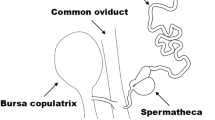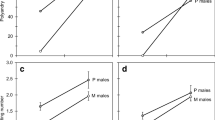Abstract
This study examines the effects of different risks of sperm competition upon ejaculate characteristics in the moth Plodia interpunctella. In this short-lived species, females will remate and thus generate sperm competition, while males have a limited sperm supply. We therefore predict males to have evolved prudence in ejaculate allocation and investigate the effects of (1) rival male presence, (2) female mating history and (3) female age, upon the ejaculation of eupyrene (fertilizing) and apyrene (non-fertile) sperm numbers. We found no effect of the presence of rival males upon ejaculate characteristics, and conclude, due to the mating system of P. interpunctella, that rival males do not represent a proximate risk of sperm competition. We controlled female mating history by allowing females to receive different and predictable numbers of sperm which they then store for at least 7 days. In subsequent matings (7 days later) we found that new males ejaculated significantly more eupyrene sperm to females that had previously received larger numbers of sperm. We conclude that males increase numbers of eupyrene sperm to maintain success in sperm competition with rival sperm already in storage in the female. We found no effect of female mating history upon the ejaculation of apyrene sperm. Female age, however, had a significant negative effect upon both sperm types. We discuss these results in relation to sperm competition theory and apyrene sperm function.
Similar content being viewed by others
References
Baker RR, Bellis MA (1989) Number of sperm in human ejaculates varies in accordance with sperm competition theory. Anim Behav 37:867–869
Baker RR, Bellis MA (1993) Human sperm competition: ejaculate adjustment by males and the function of masturbation. Anim Behav 46:861–885
Bellis MA, Baker RR, Gage MJG (1990) Variation in rat ejaculates consistent with the kamikaze-sperm hypothesis. J Mammal 71:479–480
Bieman DN, Witter JA (1983) Mating behaviour of Malacosoma disstria at two levels of mate competition. Fla Entomol 66:272–279
Brower JH (1975) Sperm precedence in the Indian meal moth Plodia interpunctella. Ann Entomol Soc Am 68:78–80
Cartar RV (1985) Testes size in sandpipers. Naturwissenschaften 72:157–158
Clark SJ (1988) The effects of operational sex ratio and food deprivation on copulation duration in the water strider Gerris remigis Say. Behav Ecol Sociobiol 23:317–322
Dewsbury D (1982) Ejaculate cost and male choice. Am Nat 119:601–610
Drummond BA (1984) Multiple mating and sperm competition in the Lepidoptera. In: Smith RL (eds) Sperm competition and the evolution of animal mating systems. Academic Press, London, pp 291–370
Friedlander M, Gitay H (1972) The fate of the normal-anucleated spermatozoa in inseminated females of the silkworm Bombyx mori. J Morphol 138:121–129
Gage MJG (1991) Risk of sperm competition directly affects ejaculate size in the Mediterranean fruit fly. Anim Behav 42:1036–1037
Gage MJG (1994) Associations between body size, mating pattern, testes size and sperm lengths across butterflies. Proc R Soc Lond B 258:247–254
Gage MJG, Baker RR (1991) Ejaculate size varies with sociosexual situation in an insect. Ecol Entomol 16:331–337
Gage MJG, Cook PA (1994) Sperm size or numbers? Effects of nutritional stress upon eupyrene and apyrene sperm production strategies in the moth Plodia interpunctella (Lepidoptera: Pyralidae). Funct Ecol 8:594–599
Gilbert LE (1976) Post-mating female odour in Heliconius butterflies: a male contributed anti-aphrodisiac? Science 193:419–420
Ginsberg JR, Rubenstein DI (1990) Sperm competition and variation in zebra mating behaviour. Behav Ecol Sociobiol 26:427–434
Greenfield MD (1982) The question of paternal investment in Lepidoptera: male contributed proteins in Plodia interpunctella. Int J Invert Reprod 5:323–330
Gross MR (1982) Sneakers, satellites and parentals polymorphic mating strategies in North-American sunfishes. Z Tierpsychol 60:1–26
Gurdon GB (1991) Nuclear transplantation in Xenopus. In: Kray B, Peng B (eds) Methods in cell biology. Academic Press, London, pp 299–306
Harcourt AH, Harvey PH, Larson SG, Short RV (1981) Testes weight, body weight and breeding system in primates. Nature 293:55–57
He Y, Tsubaki Y (1992) Variation in spermatophore size in the armyworm, Pseudaletia separata (Lepidoptera:Noctuidae) in relation to rearing density. Appl Entomol Zool 27:39–45
Jennings MT, Philipp DP (1992) Reproductive investment and somatic growth rates in longear sunfish. Environ Biol Fish 35:257–271
Kenagy GJ, Trombulak SC (1986) Size and function of mammalian testes in relation to body size. J Mammal 67:1–22
Linley JR, Hinds MJ (1975) Quantity of the male ejaculate influenced by female unreceptivity in the fly Culicoides melleus. J Insect Physiol 281–285
Lodge JR, Fechheimer NS, Jaap RG (1971) The relationship of in vivo sperm storage interval to fertility and embryonic survival in the chicken. Biol Reprod 5:252–257
Markow TA (1982) Mating systems of cactophylic Drosophila. In: Barker JS, Starmer WT (eds) Ecological genetics and evolution. Academic Press, London, pp 273–287
Martin PA, Reimers TJ, Lodge JR, Dziuk PJ (1974) The effect of ratios and numbers of spermatozoa mixed from two males on proportions of offspring. J Reprod Fert 39:251–258
McLain DK (1989) Prolonged copulation as a post-insemination guarding tactic in a natural population of a ragwort seed bug. Anim Behav 38:659–664
Meves F (1902) Uber oligopyrene und apyrene Spermien und uber ihre Entstehung, nach Beobachtungen an Paludina und Pygaera. Arch Mikrosk Anat 61:1–84
Minitab Reference Manual (1991) Macintosh Version, release 8 Minitab Inc., State College, Philadelphia
Møller AP (1988a) Ejaculate quality, testes quality and sperm competition in primates. J Human Evol 17:489–502
Møller AP (1988b) Testes size, ejaculate quality and sperm competition in birds. Biol J Linn Soc 33:273–283
Nakatsuru K, Kramer DL (1982) Is sperm cheap? Limited male fertility and female choice in the lemon tetra (Pisces: Characidae). Science 217:753–755
Norris NJ (1932) Contributions towards the study of insect fertility. 1. The structure and operation of the reproductive organs of the genera Ephestia and Plodia (Lepidoptera, Phycitidae). Proc Zool Soc 1932:595–611
Osanai M, Kasuga H, Aigaki T (1987) Physiological role of apyrene spermatozoa of Bombyx mori. Experientia 43:593–596
Parker GA (1970) Sperm competition and its evolutionary consequences in the insects. Biol Rev 45:525–567
Parker GA (1982) Why are there so many tiny sperm? Sperm competition and the maintenance of two sexes. J Theor Biol 96:281–294
Parker GA (1990a) Sperm competition games: raffles and roles. Proc R Soc Lond B 242:120–126
Parker GA (1990b) Sperm competition games: sneaks and extra-pair copulations. Proc R Soc Lond B 242:127–133
Parker GA (1993) Sperm competition games: sperm size and sperm number under adult control. Proc R Soc Lond B 253:245–554
Parker GA, Simmons LW, Kirk H (1990) Analysing sperm competition data: simple models for predicting mechanisms. Behav Ecol Sociobiol 27:55–65
Rice WR (1989) Analysing tables of statistical tests. Evolution 43:223–225
Rutowski RL (1981) Sexual discrimination using visual cues in the checkered white butterfly Pieris protodice. Z Tierpsychol 55:325–334
Rutowski RL (1982) Epigamic selection by males as evidenced by courtship partner preferences in the checkered white butterfly (Pieris protodice) Anim Behav 30:108–112
Schwagmeyer PL, Parker GA (1990) Male mate choice in thirteen-lined ground squirrels. Nature 348:62–64
Short RV (1979) Sexual selection and its component parts, somatic and genital selection as illustrated by man and the great apes. Adv Study Behav 9:131–158
Silberglied RL, Shepherd JG, Dickinson JL (1984) Eunuchs: the role of apyrene sperm in Lepidoptera? Am Nat 123:255–265
Simmons LW (1987) Sperm competition as a mechanism of female choice in the field cricket, Gryllus bimaculatus. Behav Ecol Sociobiol 21:197–202
Simmons LW, Craig M, Llorens T, Schinzig M, Hosken D (1993) Bushcricket spermatophores vary in accord with sperm competition and parental investment theory. Proc R Soc Lond B 251:183–186
Simmons LW, Llorens T, Schinzig M, Hoskin D, Craig M (1994) Sperm competition selects for mate mate choice and protandry in the bushcricket, Requena rerticalis (Orthoptera: Tettigonidae). Anim Behav 47:117–122
Sivinski J (1980) Sexual selection and insect sperm. Fla Entomol 63:99–111
Smith RL (1984) Sperm competition and the evolution of animal mating systems. Academic Press, London
Stockley P, Searle JB, Macdonald DW, Jones CS (1994) Alternative reproductive tactics in male common shrews: relationships between mate-searching behaviour, sperm production, and reproductive success as revealed by DNA fingerprinting. Behav Ecol Sociobiol 34:71–78
Sugawara T (1979) Stretch reception in the bursa copulatrix of the butterfly, Pieris rapae crucivora, and its role in behaviour. J Comp Physiol 130:191–199
Svärd L, Wiklund C (1989) Mass and production rate of ejaculates in relation to monandry/polyandry in butterflies. Behav Ecol Sociobiol 24:395–402
Telford SR, Dangerfield JM (1990) Manipulation of the sex ratio in the tropical millipede Alloporus uncinatus: a test of the copulatory guarding hypothesis. Anim Behav 40:984–986
Thibout E (1979) Stimulation of reproductive activity of females of Acrolepiopsis assectella (Lepidoptera: Hyponomeutoidea) by the presence of eupyrene spermatozoa in the spermatheca. Entomol Exp Appl 26:279–290
Tsubaki Y, Yamagishi M (1991) ‘Longevity’ of sperm within the female of the melon fly, Dacus cucurbitae (Diptera: Tephriditae), and its relevance to sperm competition. J Insect Behav 4:243–250
Wedell N (1992) Protandry and mate assessment in the wartbiter Decticus verrucivorus (Orthoptera: Tettigoniidae). Behav Ecol Sociobiol 31:301–308
Wiklund C, Forsberg J (1985) Courtship and male discrimination between virgin and mated females in the orange tip butterfly Anthocharis cardamines. Anim Behav 34:328–332
Wiklund C, Kaitala A, Lindfors V, Abenius J (1993) Polyandry and its effect on female reproduction in the green-veined butterfly (Pieris napi L). Behav Ecol Sociobiol 33:25–33
Author information
Authors and Affiliations
Additional information
Communicated by G. Wilkinson
Rights and permissions
About this article
Cite this article
Cook, P.A., Gage, M.J.G. Effects of risks of sperm competition on the numbers of eupyrene and apyrene sperm ejaculated by the moth Plodia interpunctella (Lepidoptera: Pyralidae). Behav Ecol Sociobiol 36, 261–268 (1995). https://doi.org/10.1007/BF00165835
Received:
Accepted:
Issue Date:
DOI: https://doi.org/10.1007/BF00165835




